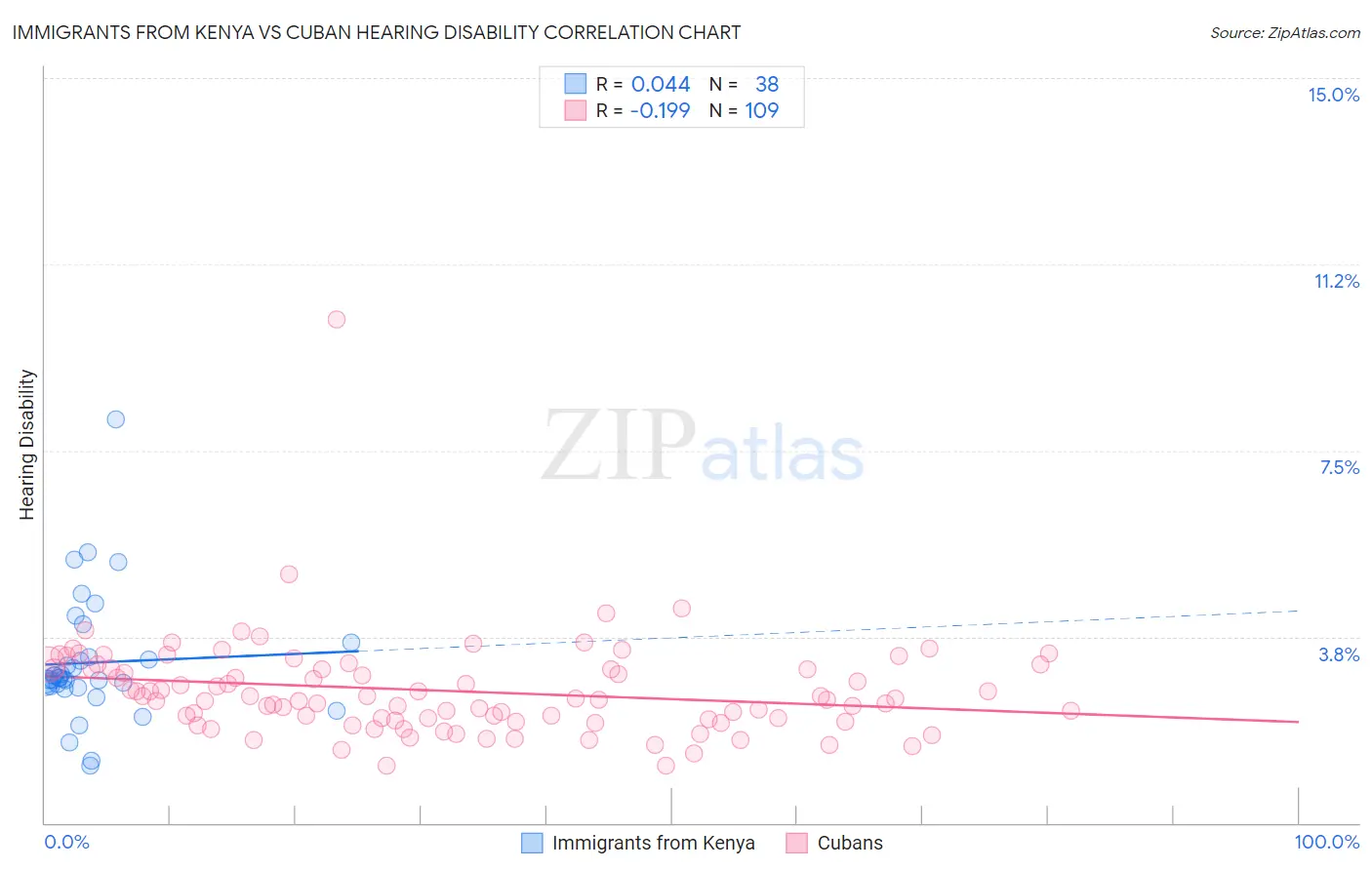Immigrants from Kenya vs Cuban Hearing Disability
COMPARE
Immigrants from Kenya
Cuban
Hearing Disability
Hearing Disability Comparison
Immigrants from Kenya
Cubans
2.9%
HEARING DISABILITY
86.1/ 100
METRIC RATING
131st/ 347
METRIC RANK
2.8%
HEARING DISABILITY
89.4/ 100
METRIC RATING
121st/ 347
METRIC RANK
Immigrants from Kenya vs Cuban Hearing Disability Correlation Chart
The statistical analysis conducted on geographies consisting of 218,040,031 people shows no correlation between the proportion of Immigrants from Kenya and percentage of population with hearing disability in the United States with a correlation coefficient (R) of 0.044 and weighted average of 2.9%. Similarly, the statistical analysis conducted on geographies consisting of 449,105,745 people shows a poor negative correlation between the proportion of Cubans and percentage of population with hearing disability in the United States with a correlation coefficient (R) of -0.199 and weighted average of 2.8%, a difference of 0.76%.

Hearing Disability Correlation Summary
| Measurement | Immigrants from Kenya | Cuban |
| Minimum | 1.1% | 1.1% |
| Maximum | 8.1% | 10.1% |
| Range | 7.0% | 9.0% |
| Mean | 3.2% | 2.7% |
| Median | 2.9% | 2.5% |
| Interquartile 25% (IQ1) | 2.8% | 2.1% |
| Interquartile 75% (IQ3) | 3.3% | 3.1% |
| Interquartile Range (IQR) | 0.57% | 1.0% |
| Standard Deviation (Sample) | 1.3% | 1.0% |
| Standard Deviation (Population) | 1.3% | 1.0% |
Demographics Similar to Immigrants from Kenya and Cubans by Hearing Disability
In terms of hearing disability, the demographic groups most similar to Immigrants from Kenya are Chilean (2.9%, a difference of 0.050%), Immigrants from Syria (2.9%, a difference of 0.060%), Immigrants from Vietnam (2.9%, a difference of 0.090%), Immigrants from Uganda (2.9%, a difference of 0.10%), and Ugandan (2.9%, a difference of 0.13%). Similarly, the demographic groups most similar to Cubans are Jordanian (2.8%, a difference of 0.030%), Liberian (2.8%, a difference of 0.090%), Kenyan (2.8%, a difference of 0.12%), Zimbabwean (2.8%, a difference of 0.14%), and Immigrants from Liberia (2.8%, a difference of 0.16%).
| Demographics | Rating | Rank | Hearing Disability |
| Immigrants | Immigrants | 90.3 /100 | #116 | Exceptional 2.8% |
| Immigrants | Liberia | 90.0 /100 | #117 | Excellent 2.8% |
| Zimbabweans | 89.9 /100 | #118 | Excellent 2.8% |
| Kenyans | 89.8 /100 | #119 | Excellent 2.8% |
| Jordanians | 89.5 /100 | #120 | Excellent 2.8% |
| Cubans | 89.4 /100 | #121 | Excellent 2.8% |
| Liberians | 89.0 /100 | #122 | Excellent 2.8% |
| Immigrants | Zaire | 88.6 /100 | #123 | Excellent 2.9% |
| Bahamians | 88.6 /100 | #124 | Excellent 2.9% |
| Immigrants | Albania | 88.5 /100 | #125 | Excellent 2.9% |
| Immigrants | Sudan | 87.8 /100 | #126 | Excellent 2.9% |
| South American Indians | 86.9 /100 | #127 | Excellent 2.9% |
| Immigrants | Western Asia | 86.9 /100 | #128 | Excellent 2.9% |
| Immigrants | Uganda | 86.6 /100 | #129 | Excellent 2.9% |
| Immigrants | Vietnam | 86.5 /100 | #130 | Excellent 2.9% |
| Immigrants | Kenya | 86.1 /100 | #131 | Excellent 2.9% |
| Chileans | 85.8 /100 | #132 | Excellent 2.9% |
| Immigrants | Syria | 85.8 /100 | #133 | Excellent 2.9% |
| Ugandans | 85.5 /100 | #134 | Excellent 2.9% |
| Soviet Union | 84.8 /100 | #135 | Excellent 2.9% |
| Immigrants | Brazil | 84.6 /100 | #136 | Excellent 2.9% |